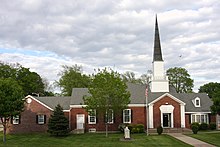| Charles Draper Faulkner | |
|---|---|
| Born | (1890-03-11)March 11, 1890 San Francisco, California |
| Died | December 31, 1979(1979-12-31) (aged 89) Downers Grove, Illinois |
| Occupation | Architect |
Charles Draper Faulkner (March 11, 1890 – December 31, 1979) was a Chicago-based American architect renowned for the churches and other buildings that he designed in the United States and Japan. He designed over 33 Christian Science church buildings and wrote a book called Christian Science Church Edifices.
Early life and education
Charles Draper Faulkner was born in San Francisco, California, After graduating from Calumet High School in Chicago, he went to Armour Institute of Technology, now Illinois Institute of Technology and in 1913 received a B.S. in Architecture. Most of his senior year at A.I.T. was spent on a traveling scholarship in Canada and six countries in Europe.
Career history
From 1913 to 1917 he worked as chief designer for renowned Chicago architect Solon Spencer Beman. In 1919 he opened his own firm in Chicago. From 1935-1937 he also did work for the U.S. government. After his son, Charles Draper Faulkner, Jr., joined him in the practice, he changed his firm name to Faulkner, Faulkner & Associates. He was a member of the Chicago chapter of the A.I.A. and held various offices from 1946 to 1954. He worked with architect Charles Sumner Duke on multiple occasions, notably on the construction of three Christian Science churches and a nursing home.
Faulkner, and later his son, where among the most prolific 20th century architects of Christian Science branch churches, designing over 160 churches during 75 years. He wrote a book in 1946, Christian Science Church Edifices, describing the importance of church architecture and how it speaks for the religion itself. The book contains many illustrations of churches, and is seen as an important book on the topic of church architecture, especially related to the Christian Science movement.
Style
Faulkner opposed excessive ornamentation and believed there was "no such thing" in a single style of Christian Science architecture; but eventually settled on the Colonial style as the most appropriate for its simplicity, cost-effectiveness, and American roots. Some of the other building styles he utilized include Romanesque, Georgian, and Renaissance-revival.
Works

Mt. Lebanon, Pennsylvania

Fairmont, Minnesota

Valparaiso, Indiana
Christian Science churches
- Note: all Churches of Christ, Scientist, are numbered: First, Second, Third, etc.
Japan
- First, Tokyo
United States
|
|
Other buildings
Chicago
- Beverly Unitarian Church, school building, 1959, Chicago
- Oakhaven Old People's Home, 1922, with Charles Sumner Duke
- 6737 S Bennett Avenue, 1927
- 6835 S Bennett Avenue, 1925
- 6907 S Bennett Avenue, 1926
- 6921 S Bennett Avenue, 1910s
- 6841 S Constance Avenue, 1920s
- 6845 S Constance Avenue, 1925
- 6757 S Cregier Avenue, 1920s
- 2666 E 73rd Street, 1928
- 2309 E 71st Street, 1920s
- 635 E. 79th St., Chicago, Illinois
- 8030 S. Cottage Grove Ave., Chicago, Illinois
Other buildings include some of those found in the South Shore, Morgan Park, and the Jackson Park Highlands Chicago Landmark District.
Elsewhere
- Good Shepherd United Protestant Church, 1957, Park Forest
- Trinity Episcopal Church, 1958, Wheaton, Illinois
- Nippersink Resort buildings, Genoa City, WI
- The Shinner Memorial Playground Clubhouse, 1932
Death
In 1979, Charles Draper Faulkner died a resident of Downers Grove, Illinois.
Daystar Foundation in Oklahoma City houses a collection of Faulkner and his son's architectural drawings, photos, slides, documents, and other historical items.
Published works
- Christian Science Church Edifices. 1946.
References
- Historic Designation study report
- Wilson, Dreck Spurlock (2004). African American Architects: A Biographical Dictionary, 1865-1945. Routledge. p. 173. ISBN 978-1-135-95629-5.
- ^ "Faulkner Christian Science Church Architecture Collection Comes to Daystar". Daystar Foundation & Library. 4 June 2024.
- "Structures of Truth and Love: Artifacts from Christian Science Branch Church History". Daystar Foundation. April 6, 2021.
- Burr, Nelson (1961). A Critical Bibliography Of Religion In America. Princeton University Press. p. 789.
- ^ Hautzinger, Daniel (11 May 2021). "The Varied Lives and Architecture of Chicago's Christian Science Churches". WTTW Chicago.
- Stern, Robert A. M. (1987). New York 1930 : architecture and urbanism between the two world wars. Rizzoli. p. 164. ISBN 978-0-8478-0618-8.
- Harris, Neil (2004). Chicago apartments: a century of lakefront luxury. Acanthus Press. ISBN 978-0-926494-25-1.
- ^ Faulkner, Charles Draper (1946). Christian Science Church Edifices (2nd ed.). Chicago, IL: Faulkner. p. 20.
- ^ City of Chicago Landmark Designation Reports. 2007.
- ^ Faulkner, Charles Draper (1946). Christian Science Church Edifices (2nd ed.). Chicago, IL: Faulkner. p. 21.
- "Beverly Unitarian Church history". Archived from the original on 2008-08-20. Retrieved 2008-04-24.
- From the architect's drawings